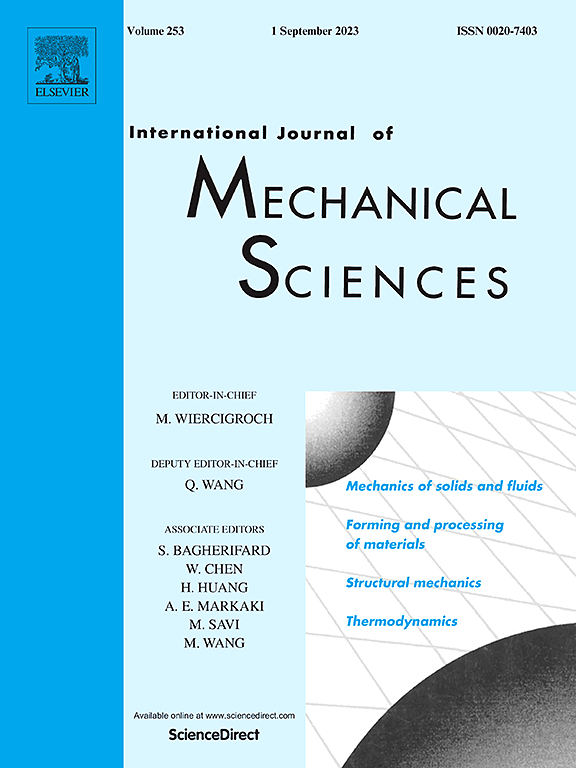基于强化学习的椭圆圆柱涡脱落抑制
IF 7.1
1区 工程技术
Q1 ENGINEERING, MECHANICAL
International Journal of Mechanical Sciences
Pub Date : 2025-07-14
DOI:10.1016/j.ijmecsci.2025.110517
引用次数: 0
摘要
钝体的流动控制在工程应用中起着至关重要的作用。在本研究中,采用深度强化学习(DRL)来制定流动控制策略,以通过被限制在两壁之间的椭圆圆柱体。主要目的是研究在保持低控制能量输入的情况下,实现不同展弦比(Ar)椭圆圆柱体多目标流动控制的可行性。DRL训练结果表明,对于较大Ar的椭圆圆柱,控制策略能有效降低阻力,使升力波动最小化,完全抑制涡流脱落,同时保持较低的外部能量消耗。相反,减小Ar会损害多目标控制的有效性,即使在使用更大的能量输入时也是如此。通过详细的物理分析,确定了阻塞比(β)和Ar之间的耦合效应是抑制旋涡脱落和稳定尾迹的限制因素。在较低的β值下,该控制策略成功地实现了椭圆圆柱体在整个Ar范围内的多目标优化。尽管对于高度细长的圆柱体,平衡能量效率和控制性能仍然是一个挑战,但所提出的DRL策略仍然有效地抑制了旋涡脱落。这项工作强调了基于drl的控制策略的潜力,可以有效地稳定细长钝体周围的尾流,并明确强调保持能量效率。本文章由计算机程序翻译,如有差异,请以英文原文为准。

Vortex shedding suppression in elliptical cylinder via reinforcement learning
Flow control of bluff bodies plays a critical role in engineering applications. In this study, deep reinforcement learning (DRL) is employed to develop flow control strategies for the flow past an elliptical cylinder confined between two walls. The primary objective is to investigate the feasibility of achieving multi-objective flow control for an elliptical cylinder with varying aspect ratios (), while maintaining low control energy input. DRL training results demonstrate that for an elliptical cylinder with larger , the control strategy effectively reduces drag, minimizes lift fluctuations, and completely suppresses vortex shedding, all while maintaining low external energy consumption. Conversely, decreasing the compromises the effectiveness of multi-objective control, even when greater energy input is applied. Through detailed physical analysis, the coupling effect between the blockage ratio () and is identified as a limiting factor for vortex shedding suppression and wake stabilization. At lower values of , the control strategy successfully achieves multi-objective optimization for elliptical cylinders across the entire range of . Although balancing energy efficiency and control performance remains challenging for highly slender cylinders, the proposed DRL strategy still achieves effective vortex shedding suppression. This work highlights the potential of DRL-based control strategies to effectively stabilize wake flows around slender bluff bodies, with an explicit emphasis on maintaining energy efficiency.
求助全文
通过发布文献求助,成功后即可免费获取论文全文。
去求助
来源期刊

International Journal of Mechanical Sciences
工程技术-工程:机械
CiteScore
12.80
自引率
17.80%
发文量
769
审稿时长
19 days
期刊介绍:
The International Journal of Mechanical Sciences (IJMS) serves as a global platform for the publication and dissemination of original research that contributes to a deeper scientific understanding of the fundamental disciplines within mechanical, civil, and material engineering.
The primary focus of IJMS is to showcase innovative and ground-breaking work that utilizes analytical and computational modeling techniques, such as Finite Element Method (FEM), Boundary Element Method (BEM), and mesh-free methods, among others. These modeling methods are applied to diverse fields including rigid-body mechanics (e.g., dynamics, vibration, stability), structural mechanics, metal forming, advanced materials (e.g., metals, composites, cellular, smart) behavior and applications, impact mechanics, strain localization, and other nonlinear effects (e.g., large deflections, plasticity, fracture).
Additionally, IJMS covers the realms of fluid mechanics (both external and internal flows), tribology, thermodynamics, and materials processing. These subjects collectively form the core of the journal's content.
In summary, IJMS provides a prestigious platform for researchers to present their original contributions, shedding light on analytical and computational modeling methods in various areas of mechanical engineering, as well as exploring the behavior and application of advanced materials, fluid mechanics, thermodynamics, and materials processing.
 求助内容:
求助内容: 应助结果提醒方式:
应助结果提醒方式:


